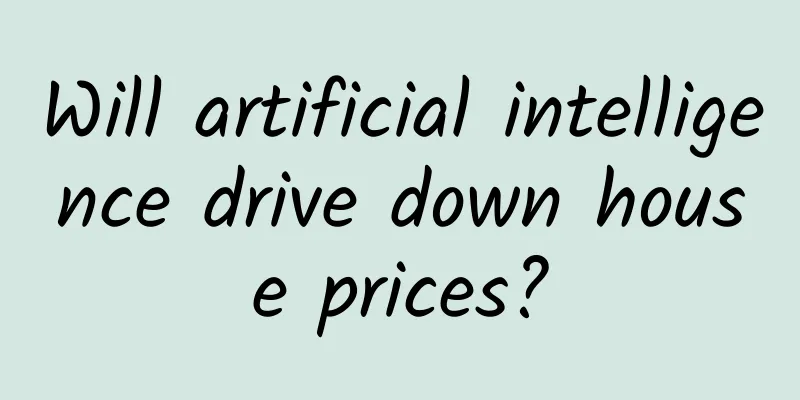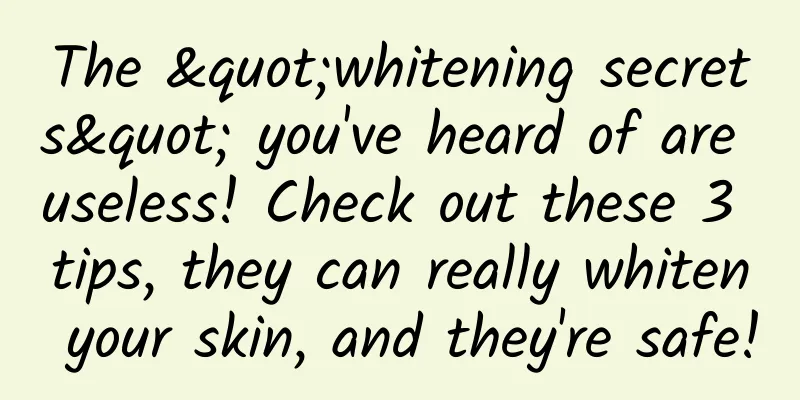Will artificial intelligence drive down house prices?

|
On October 13, the US government issued two reports: "Preparing for the Future of Artificial Intelligence" and "U.S. National Artificial Intelligence Research and Development Strategy Plan". Baidu's Robin Li believes that artificial intelligence is the future. At the same time, 360's Lao Zhou recently published an article " How Big is the Bubble of Artificial Intelligence " to explore the implementation of artificial intelligence in search and entertainment. There is no doubt that artificial intelligence has become a hot topic in this period, but how is it different from the past? Is it another collective illusion of people or has a revolution sweeping society and enterprises really begun? What are the core constraints? This article explores this question. The development of artificial intelligence is a snowball The development of new technologies is never due to people's preferences and enthusiasm, but relies on the positive feedback loop between technology and business (sometimes military). The smaller and stronger CPUs and the continuous improvement of network speeds are actually the result of this positive feedback. The two previous failures of artificial intelligence were ugly, mainly because they had vision but did not actually generate much commercial value. Our society and economy are heavily dependent on human intelligence. It can be said that intelligence is the foundation of human civilization, and artificial intelligence is a substitute for human intelligence, so artificial intelligence has never lacked vision. Any breakthrough in any aspect, such as image recognition, can be associated with many scenarios such as housekeeping and checking traffic violations. What AI has always lacked is that it can really generate commercial value continuously. In the case of housekeeping and checking traffic violations, it means that it must be technically accurate enough to reduce the false alarm rate, and can really perform some of the duties of people and reach a usable level. Reaching a usable level can be seen as a starting point for implementation. After that, further investment is needed to expand this commercial value, such as not only guarding the house but also patrolling, not only checking traffic violations but also assisting driving. If both of these two conditions are met, namely, initial availability and investment can amplify commercial value, then a positive feedback between technology and business can be formed. Once this positive feedback is formed, the spread of this technology cannot be changed by human power. The first wave of artificial intelligence was more restricted by the first point. People at that time did not seem to find particularly good applications for artificial intelligence. The second wave of artificial intelligence was more stopped at the second point. In the 1980s, some expert systems were indeed successfully deployed and saved companies tens of millions of dollars. For example, the first successful commercial expert system R1 was successfully operated in DEC. Since then, DEC has successively deployed 40 expert systems, but this expansion obviously did not obtain sustained returns and could not be sustained. The reason why this wave of artificial intelligence looks a little different is that this positive feedback has been initially formed, and its scope and depth have greatly increased compared with the previous two times: Technically, Deep Learning has greatly improved the accuracy of speech recognition, for example, speech recognition has increased from 70% about 20 years ago to more than 95% now. At the same time, the continuous progress of GPUs has continuously improved computing speeds. According to data from nVidia, the computing cards launched for artificial intelligence have a 60-fold increase in training speed and a 16-fold increase in inference speed compared to traditional dual-core Xeon platforms. In business, machine learning has become a standard feature. DeepMind tried to apply AlphaGo's algorithm to Google's IT operations, which resulted in a 40% reduction in operating expenses. Apple uses machine learning to improve user experience in various areas, such as the anti-mistouch feature on the iPad Pro stylus. Overall, it can be said that the full penetration of AI into various industries has become a basic trend. At this point, we can at least say that the first spiral of positive feedback has started, but the first spiral alone is not enough for the White House to take action, so what needs to be discussed is what will happen after this spiral starts? There must be something big enough for this positive feedback to continue. All industries are advocating artificial intelligence In fact, artificial intelligence can be applied in any field. If we have to classify it, it can be roughly divided into three basic categories: one is the human-computer interaction method (including voice interaction and new display methods such as AR); one is front-end automation; and one is back-end data processing. In human-computer interaction, the most typical examples are voice interaction and AR. The word AR can be defined in a very complex way. For example, it can be the commonly mentioned glasses (Microsoft Hololens, Meta, etc.), or a functional feature of a mobile phone such as Tango, or of course an application function, such as Pokeman. But I personally think that AR is essentially a change in the way of interaction. The core feature of this interaction is the real-time mixing of digital space and real space. The core technology is the breakthrough in artificial intelligence. As for the specific products, they are different applications of this interaction method. Voice interaction is what we often call Siri, Echo, etc. The reason why this change in interaction mode is important is that it will give rise to new general-purpose computing platforms, which in turn will lead to changes in the entire ecosystem, such as the invention of the mouse that promoted the transition from Dos to Windows. When discussing the interaction method, the interesting point is that it does not seem to be a rigid demand, but in fact it is the core of the replacement of general-purpose terminals, and its impact is extremely far-reaching. For example, one of the reasons for the change from PC Internet to mobile Internet is the development of touch screens. Touch screens are non-precisely positioned, and you cannot access each link as accurately as in a PC browser, so the operation area must be large enough, so various representative mobile Internet apps (Taobao, Meituan, Toutiao, etc.) have been formed to replace traditional web browsing on PCs. . The most typical examples of front-end automation are autonomous driving and robots. Before this breakthrough in artificial intelligence, all automation can be called automation under limited rules. The fundamental difference between the two types of automation is more easily seen from the implementation of software. In the past, software was actually full of conditions and branches such as "if (condition A is met), then (take a certain action)". The reason why software such as Office Word and even Windows look very powerful is that there are enough nested conditions. But now the program based on deep learning is not like this. It first trains a model, then throws new input to the model and lets the model figure it out (Inference). In other words, traditional programs can be precisely controlled, but deep learning programs cannot control the details. The degree of automation that can be achieved by applying this program difference to autonomous driving and robots is obviously fundamentally different. For example, during production, the automation of the former program can only allow specific robots to produce specific products such as cars on the assembly line, while the latter can produce robots that can do everything. What this robot can ultimately do depends on how you train it. The application scope of the latter robot is undoubtedly far greater than that of the former, but for the time being, the latter robot is indeed not as good as the former in terms of operating accuracy. The far-reaching impact of this automation upgrade is that it can realize unmanned operation in various fields in turn. For example, unmanned operation of drones + excavators can be realized in construction (the direction that Skycatch and Komatsu are trying), and unmanned operation on production lines in factories can be realized (the direction that Baxter is trying). A typical application of back-end data analysis is the big data analysis program of IBM Watson. IBM chose the medical field as a breakthrough point, which is actually very reasonable. Generally speaking, historical medical data is usually well labeled, and the breakthrough in image recognition technology can be used to view various medical films. Viewing medical films is actually equivalent to identifying the pathological pattern on the picture, and even the most experienced doctors will be abused by artificial intelligence in this regard. Of course, this kind of data analysis is definitely not limited to the medical field. The same model can be applied to finance, security, construction, etc. After looking at the three major landing directions of artificial intelligence, let’s return to the positive feedback between technology and business: First, the breakthrough of deep learning + GPU has led to breakthrough progress in recognition rate and speed of speech recognition and image recognition. Then, this breakthrough has been applied in some existing fields, such as face recognition. Of course, both are accompanied by continuous investment of capital. Then, some larger fields began to become hot, such as human-computer interaction, autonomous driving, data analysis, etc. mentioned above, at this time, various capitals will intervene to a greater extent. What we need to wait for is real progress in these major fields. Once they make progress and are successfully operated, this wave of artificial intelligence will be completely implemented, and the scope of application will continue to expand, and the technology itself will become faster and stronger. If these major fields fail to make progress, for example, if no successful projects are seen in the next five years, then this wave of artificial intelligence may cool down again. The Internet failed to lower housing prices, but artificial intelligence can? If this wave of artificial intelligence really takes off, it will definitely affect employment. Many people have discussed this, so I won’t go into details here. Instead, I want to discuss a brain-opening question: Can the development of technologies such as artificial intelligence reduce housing prices? Regardless of the details, the basic reason for the increase in housing prices is that the population is concentrated in a few areas, and the supply of houses in a few areas is limited. Therefore, in areas with a net outflow of population, such as Liaoning, housing prices are very unstable, and the downward trend is even more obvious. The core question is: Does the development of technology help to create more and more centralized cities, or does it make cities decentralized? If the answer is the former, then technology is the force that boosts the rise in housing prices in central areas. If the answer is the latter, then the development of technology is the opposite of high housing prices. So far, economic development has always promoted centralization. The more complete the supporting facilities in a place, the more developed the economy; the more developed the economy, the more complete the supporting facilities. It can be said that there is an inevitable connection between economic development, urban centralization and high housing prices. However, technologies such as artificial intelligence seem to be the opposite of high housing prices. If AR is really advanced enough, remote work will become possible, high-quality education will no longer rely on the always insufficient supply of teachers, and high-quality medical care will be untied from the region. In that case, people can get jobs and high-quality education, medical care and other social services anywhere, so why do they need to live in places with high housing prices? There are always two possibilities for future population distribution: One is that large cities like Beijing gradually expand and become super cities that can absorb 100-200 million people. This trend is repeated in various provinces, and each province becomes a local super city, while third- and fourth-tier cities and rural areas gradually disappear. One is that the population is relatively evenly distributed, and everyone can find a place he likes. Although it is far away from the hustle and bustle, life is extremely convenient. Technologies like artificial intelligence seem to be on the latter side. summary What I said above is actually part of what I want to express in the new book " Ultimate Replication: How Artificial Intelligence Will Drive Great Social Change ". Our future is still vague in details, but artificial intelligence is 100% certain to redefine the future. That is why many people have come out from schools (such as Yan Shuicheng of 360 Artificial Intelligence Research Institute from the National University of Singapore) and research institutes (such as Chen Xiaoliang of Sound Intelligence Technology from the Institute of Acoustics of the Chinese Academy of Sciences) to embrace this wave. As a winner of Toutiao's Qingyun Plan and Baijiahao's Bai+ Plan, the 2019 Baidu Digital Author of the Year, the Baijiahao's Most Popular Author in the Technology Field, the 2019 Sogou Technology and Culture Author, and the 2021 Baijiahao Quarterly Influential Creator, he has won many awards, including the 2013 Sohu Best Industry Media Person, the 2015 China New Media Entrepreneurship Competition Beijing Third Place, the 2015 Guangmang Experience Award, the 2015 China New Media Entrepreneurship Competition Finals Third Place, and the 2018 Baidu Dynamic Annual Powerful Celebrity. |
<<: Street lamps can be transformed into car charging stations that can provide WiFi
>>: Charging and battery swapping modes: who is reliable and who is cheating?
Recommend
How can we-media write explosive articles? Use these 5 steps!
What should a complete advertising copy contain? ...
How important is the attribution model in multi-channel promotion? The secret to quickly reducing conversion costs!
Today I would like to talk to you about the value...
After checking in at so many "Shuizhai Miao" bubbles, even the "mud" is so beautiful!
Songyuan City, also known as "Bodune, New Ci...
Practical model of private domain traffic operation in vocational education
This article will explain in more detail what &qu...
The marketing secret behind Lancôme’s nationwide popular promotions!
Recently, Lancôme's Spring Festival Garden Pa...
360 brings in the Coolpad master: How much of a role can he play?
Qihoo 360 invested 400 million US dollars to form...
iOS static library development
Introduction In enterprise development, some core...
Cook says Apple Watch apps now exceed 3,500 and may be launched in more countries by the end of June
Beijing time, April 28, according to the technolo...
Making money by taking advantage of men's weaknesses, sharing how to play social dating projects
It was probably a coincidence. Just when I was ab...
Tutorial on making funny animation short videos of couples with a mobile phone, you can quickly get started even if you have no basic knowledge
: : : : : : : : : : : : : : :...
Hsu Chi's personal information: What conditions are needed for website keyword ranking optimization?
With the rapid development of the Internet, compa...
The moon protects the earth from many small celestial body impacts. Netizens are grateful: It is worthy of being a satellite!
Dahe.com (Reporter Mo Shaohua) Chanjuan, Yu Gou, ...
[Smart Farmers] Rice field farming "Kaleidoscope": It turns out that these aquatic products can be grown in rice fields
In recent years, under the guidance of the Party ...
Launch in the first half of the year! Chang'e 6 is here!
According to the National Space Administration, o...









